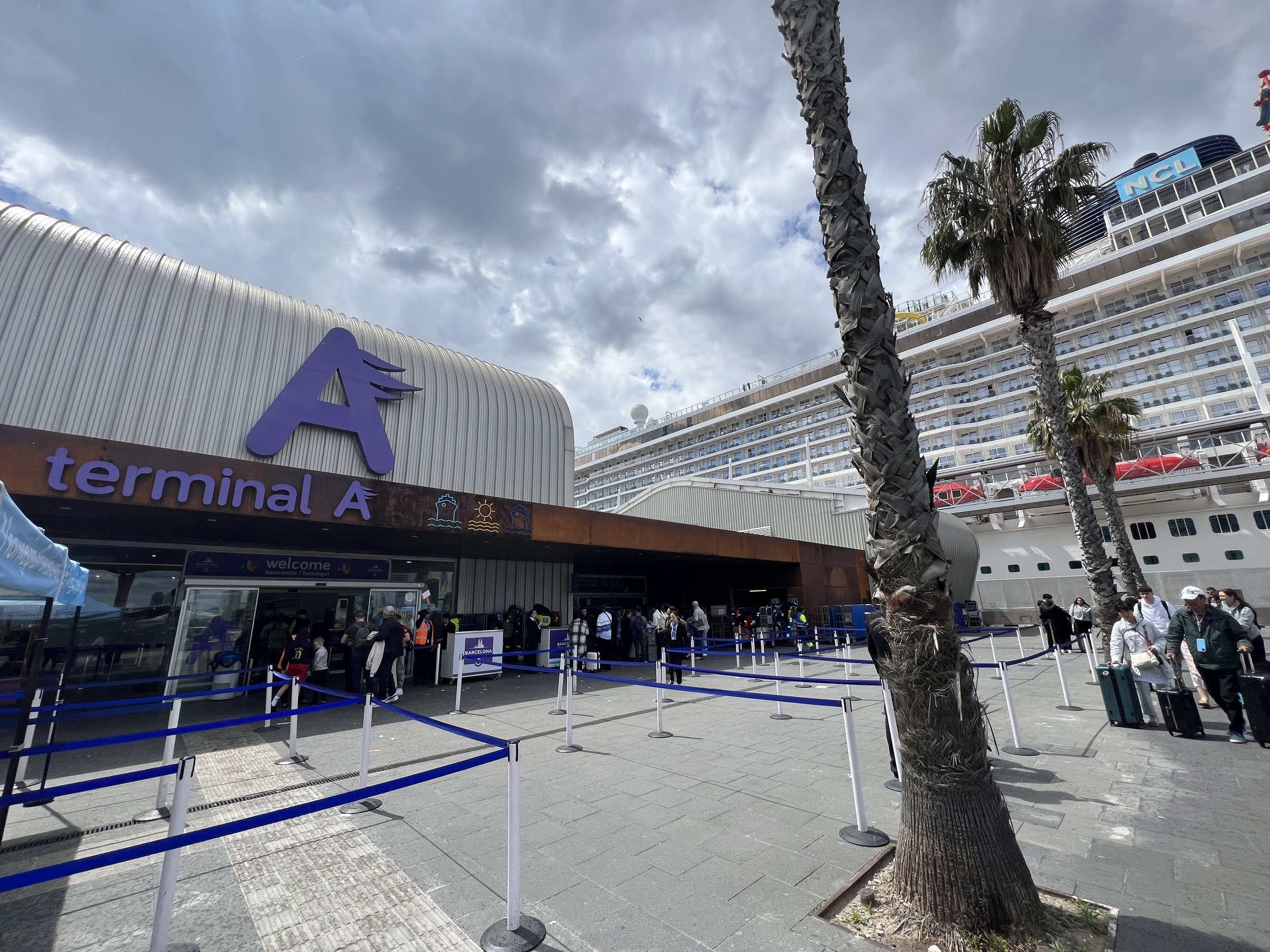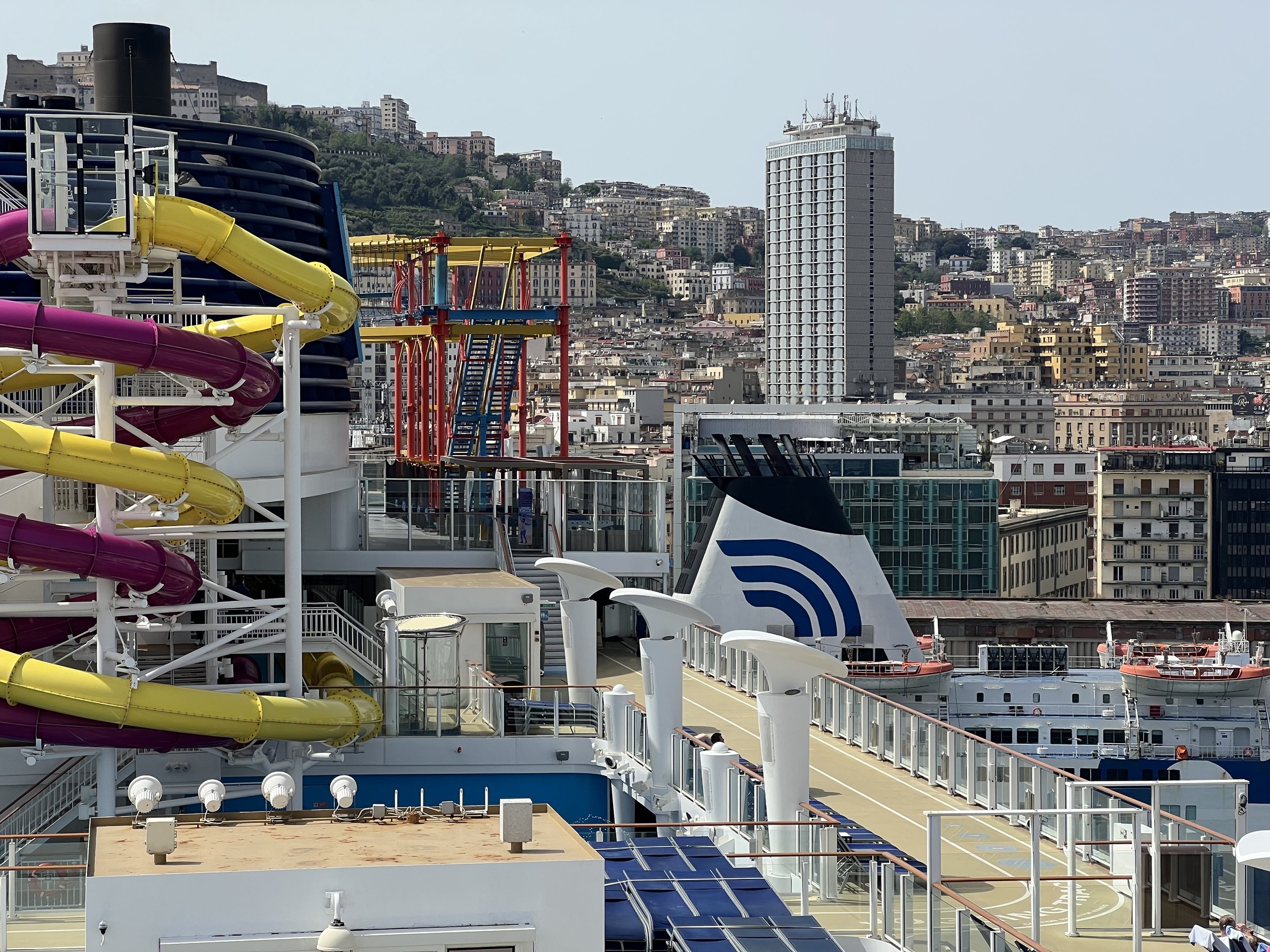10 Things I Wish I Knew Before Taking my First Mediterranean Cruise
If you’re new to cruising in Europe, then there’s one thing that you need to know: cruising in this part of the world is very different when compared to what you might be used to elsewhere.
There are lots of different reasons for this - some cultural, some environmental, and a whole host of other reasons, too. In this post, I’m going to share with you 10 things that I wish I knew before taking my first Mediterranean cruise, as some of them caught me by surprise!
I started my ‘cruise life’ where most people do - in the Caribbean. I thought cruises were all sunshine, sandy beaches and everything else that the Caribbean brings to the table. However, it wasn’t until I took my first cruise in Europe that I realised how wrong I really was…
If you enjoy this post today, I’d really appreciate your support over on YouTube. You can find my channel to subscribe by searching ‘Fraser at Sea’, or by clicking here.
Cruising in the Mediterranean can be very different to elsewhere in the world!
1. I wish I knew how different (and unpredictable) the weather can be on a Mediterranean cruise!
I’ve taken so many Caribbean cruises, where I’ve been able to predict really accurately what the weather will be like throughout my trip. Basic weather apps (I use the one available on my iPhone) do a pretty good job of predicting the weather in places like the Caribbean, because it’s not overly changeable for large parts of the year.
The Mediterranean, on the other hand, can be MUCH more difficult to predict. On some days, your port of call can experience what feels like all 4 seasons, with blazing hot sunshine, rain, hail and high winds all highly possible for some. This means that, for a part of the year, it’s important that you prepare for your cruise in this part of the world by packing more carefully (and maybe also taking a few extra layers).
I’ve met people on ships who stay on the ship all day because they’ve not packed for the weather, and they can’t leave the ship as it’s raining outside. Some of these people have travelled hundreds (and sometimes thousands) of miles, and I always think it must be SO frustrating to be stuck onboard because you haven’t thought more carefully about what to pack.
I’ll never take a Mediterranean cruise without things like a waterproof jacket, a poncho (yes, I’m one of ‘those’ people), and a couple of jumpers - it’s fairly common when the ship’s at sea in the evening for the outside air to be quite cool in Europe, and so I like to wrap up a little if I’m walking the decks after my evening meal.
The weather ‘out on deck’ can be highly changeable in Europe - pack accordingly!
2. I wish I knew that the local currency can change on a Mediterranean cruise.
On a Mediterranean cruise, you’ll find that there’s a high chance that the countries you’re visiting will use the same universal currency: the Euro. This simplifies things in a lot of cases, as you’re able to easily think about how cheap/expensive whatever you’re considering buying is, as you only have to think about one exchange rate.
However, lots of Mediterranean cruises will call to ports that use different currencies, and this can catch you off-guard, and can confuse you. In my case, I recently travelled from Dubai to Marseille (through the Suez Canal). This meant that I had multiple different currencies on my journey, and I was caught by surprise in one of the ports when I realised that I had no idea what currency was even being advertised - oops!
In short, do a little homework before you travel to be on the safe side - it’s always good to know how much something’s going to cost you before you put your credit card into the reader…!
In most ports that you visit, you’re going to be absolutely fine to use your credit/debit card to make purchases. However, there may be some places where you’d prefer to use cash. You should be able to exchange currency at Guest Services on your cruise ship, so there’s no real need to do this before your cruise - just check that your ship has this facility before you go!
Remember - currency can change while you’re cruising in Europe - always check what currency you’re being charged in before you agree to buy something!
3. I wish I knew how overwhelming the history can be on a Mediterranean cruise!
As someone who grew up in Europe, I was well aware of the fact that the history across this continent is amazing. However, I never took a cruise growing up, so I was more used to visiting a city for a number of days at a time, rather than for just one day as part of a cruise.
On my first Mediterranean cruise, I remember trying to work my way around a museum as quickly as possible, so that I could get out and see the next attraction. I felt like I was frantically rushing around, and I was completely overwhelmed by the time I returned to the ship in the evening.
It’s important to set your expectations for cruising to Europe - don’t plan to learn everything about every city that you visit on your cruise. In reality, you should probably focus on properly absorbing one or two attractions during your cruise call (depending on the size of them), with the aim to then return and see more on a future visit.
Personally, I love taking a walking tour in a city, which takes only a couple of hours. This allows me to leave the cruise ship, learn a few interesting facts about where I am while walking around with a guide, and then I can do some exploring on my own. I usually book through Viator, which is a site that connects you to local guides. Booking through Viator then means that you’re supporting local people, rather than supporting large tour operators that often operate on cruise line excursions. You can click here to learn more about Viator, or search for available tours for your next trip!
I recently used Viator for a walking tour in Split, Croatia - a great way to learn a little about the city!
4. I wish I knew about ‘Tender Ports’, and what this means for a cruise call.
Did you know… Some cruise ports will allow a cruise ship to dock, meaning that a gangway will be attached to the ship, and passengers will then be able to walk ashore. For others, there’s no docking facilities, and so cruise ships are required to drop their anchors slightly offshore, and then use much smaller boats to take their passengers ashore.
This can be the case for a whole number of reasons: maybe there’s coral or marine life under the surface that the ships could damage, maybe there’s lots of rocks nearby, or maybe the place you’re visiting just isn’t established enough to have built a cruise dock yet.
For most cruise lines, you’ll be required to book a spot on what’s called a ‘tender’, if you’re keen to get off the ship early in the day. This usually means that you’ll use a digital screen onboard, the mobile app, or speak to Guest Services, and you’ll be able to select which time you’d like to leave the ship. The earlier you book your slot, the more chance there is of you getting booked onto one of the first boats.
When you get onto your ship, just ask which of your ports are tender ports, and ask for confirmation of the tender booking process. That way, you can book your ticket as early as possible and you won’t be left disappointed or frustrated.
Note: if you book an excursion with the cruise line, you’ll usually get priority tender access, meaning that you’ll get off of the ship before those who haven’t booked an excursion - a useful tip to remember!
Some cruise ports will be ‘tender ports’, where the cruise ship won’t be able to dock and will therefore use smaller boats to ferry guests ashore.
Here’s a ‘tender boat’ up close. This one was used during my cruise on NCL Breakaway. These can usually also be used as lifeboats.
5. I wish I knew that cruise ships can sometimes dock pretty far out of town on a Mediterranean cruise!
On my first ever Caribbean cruise, I was really surprised by just how close the ship was able to get to the the main attractions that I was interested in seeing. This, however, isn’t always the case when you take a cruise in Europe.
There are some cities on a Mediterranean cruise that cruise ships will be able to dock pretty closely to the action, but others where you’ll be required to travel once leaving the ship. Two examples of cities that cruise ships can dock pretty close to would be Genoa and Naples, where you’re only a few minutes walk from the main city area when you leave your ship. Look at these photos below - the ships are SO close!
Genoa Cruise Port: right in the heart of the action!
Naples Cruise Port - the city’s right beside the ship!
On the other hand, an example of a port that the cruise ships really can’t get close to the city would be Rome. You’ll find ‘Rome’ on most Mediterranean cruise itineraries, but the reality is that you’ll probably dock at Civitavecchia, a town about 25 minutes by train out of Rome itself. By the time you leave the ship and make your way into the city of Rome, you’ll have used up a fair amount of time.
Civitavecchia - the cruise port ‘local’ to Rome. This one is still a train ride away from the city!
The moral of the story here is to check the location of your cruise ports before you decide on what you’d like to do in port - you might be arriving into the city on your ship, but you might not be!
While we’re talking about cruise ports, would you like to see what it’s like to visit Naples, the birthplace of PIZZA, for a day on a cruise? You might enjoy my YouTube video below…
6. I wish I knew about the sheer number of tourist scams in European cruise ports!
This is one that really surprised me during my first few European cruises, and something that really does make me angry when I see people getting caught out. Unfortunately, all around the world, there will always be people who try to gain dishonestly from tourists.
This could mean pick-pocketing, or it could mean someone pretending that they’re giving a tourist something for free (usually something like a bracelet). Once the ‘free’ bracelet is tied onto the tourist’s wrist, payment is demanded, with the scammer becoming frustrated and angry.
There are other scams too - a well known one in Paris is where groups of ‘scammers’ work together to pretend that they’re gambling on the street. Obviously, they’re using fake money, in the hope that a tourist will come along to join in (with their real money, of course…).
Can you imagine how much it would ruin your day to return to your cruise ship in the evening to know that someone ashore had your iPhone, your camera, your wallet, or even just some of your money?
My general rule of thumb is to avoid interacting with people who seem suspicious when I’m visiting a town/city by cruise ship. If something seems ‘too good to be true’, it probably is.
7. Some European cruise ports will be VERY busy during your cruise visit!
During my first few Mediterranean cruises, I was surprised (and sometimes quite shocked, to be honest) at how busy some of the ports I was visiting were. This was partly due to the fact that some of these places are hugely popular tourist options (think Barcelona, Naples etc), but also due to the fact that multiple cruise ships were in port at the same time as mine was.
I’ve seen the port of Barcelona accommodate 5 (and sometimes even more, depending on their size) cruise ships, which is such a huge amount of people! Think about it - if a modern cruise ship can accommodate 4,000 - 6,000 people, that’s a huge amount of people descending on the city for the day.
Why is it important that you think about this when planning your cruise? Well, think about it. Lots of these people are going to want to check out the top attractions in the city, meaning that they’re going to get VERY busy. In the example of Barcelona, lots of these cruisers will want to check out places like Basilica de la Sagrada Familia, the world-famous cathedral. This is why it’s so important to plan your day carefully, as simply ‘turning up’ to go inside will often result in you finding that there are no tickets left. This is where sites like Viator (click here) can come in SO useful - you can buy your tickets to top attractions in advance to avoid any worrying!
If you’re visiting Barcelona, you’ll want to check out Basilica de la Sagrada Familia!
One word can describe this place… WOW!
8. I wish I knew that ‘Embarkation’ can take place on multiple days of a Mediterranean cruise.
On most cruises, if you’re on a 7-night cruise, that will be the case for all of the passengers onboard. Everyone will board the ship on day 1, and then everyone will leave on the final morning. When you cruise in the Mediterranean, it’s often a slightly different story, with multiple embarkation (and disembarkation) days throughout your cruise.
What does this look like on a typical itinerary?
Some cruise lines (think MSC Cruises and Costa Cruises, for example) will offer embarkation and disembarkation at almost every port of a Mediterranean cruise, meaning that passengers can start or end their cruise at any of the ports. This means that, for most of your ports, you’re going to be filtered through large cruise terminals, rather than simply ‘walking off’ the ship like you would in the Caribbean, for example.
Other cruise lines - think Royal Caribbean as an example - will sometimes offer two embarkation/disembarkation points during a 7-night cruise. These are usually, in my experience, Barcelona and Civitavecchia on a Mediterranean itinerary.
Personally, I really like the fact that cruise lines offer this, as it alleviates so much stress and pressure on a cruise terminal when they’re not trying to process boarding documents for 5,000+ passengers in a single day. Instead, they’re maybe only processing 1,000 new passengers. Not only does this make boarding the ship significantly more efficient, but it also makes things like leaving the ship, collecting your luggage, and getting into a taxi outside the terminal at the end of your trip much more straight forward!
It’s important to think about this, as you might be able to bring the cost of your cruise down by exploring different embarkation ports. If it’ll cost you the same to fly to Barcelona vs Rome, why not check out the two options? You might save yourself a small fortune on your cruise fare!
Remember: you don’t always need to check prices for Barcelona when you cruise in the Mediterranean - other options are often available!
9. I wish I knew how easy it was to see another European city when I cruise the Mediterranean.
This is a point that I’ve got much better at over the last few years. For my first few cruises, I would fly out to meet the ship, take the cruise, and then fly home again as soon as the ship arrived back into port.
Now, I try (where possible) to spend a little time local to the cruise port enjoying the city itself, or seeing if there’s another local city I could take a low-cost flight to, in order to see another place and also extend my vacation. This has allowed me to really fall in love with cities like Barcelona!
I know so many people who see Barcelona as the city they board/leave their cruise ship in, and they don’t know it for much else. I genuinely think these people are at SUCH a loss, as it’s fast become one of my favourite cities anywhere in the world. If you’ve travelled to a city to board your cruise ship, why not extend your trip by a night or two and enjoy what they’ve got to offer?
Barcelona’s just one example of a city that’s great to enjoy before or after a cruise, but there are so many others out there! Who knows - doing this might allow you to also find your new favourite spot…
Spend some time exploring the city, rather than visiting only to cruise!
Barcelona has SO MUCH to offer tourists - why not stay a few nights and experience it for yourself before, or after, your cruise?
10. On your Mediterranean cruise, remember that Siesta culture exists in Europe!
If you’ve never visited Europe before, you might be new to the concept of a Siesta. Well, you’re going to be glad you’re still reading, because this one can massively affect your trip, especially if you’re visiting a city by cruise ship.
A Siesta is where locals enjoy some ‘down time’ in the afternoon, and this exists in various countries throughout Europe. I’ve found it to be most common in places like Spain, especially if you’re cruising to the more ‘local’ ports. You should expect to see that, around lunchtime, many of the shops and attractions will close, offering locals the opportunity to relax during the ‘heat of the day’, and usually also enjoy some family time.
When I started cruising in Europe, this really frustrated me, as I would tend to enjoy a relaxed morning onboard the ship followed by a walk around the city. By the time I was off the ship, places would be starting to close - argh! However, I’ve learned that in future, I’d be better planning to get off of the ship earlier, visit the places that will close for Siesta in the morning, and then aim to eat somewhere around lunchtime. Note: you’ll often find cafes, coffee shops etc remain open, as this is there ‘family time’ will often be enjoyed by some of the locals!
I absolutely love, when cruising somewhere that’s not a big city, to take a walk through the more residential areas early/mid-afternoon. At that point, you’ll often see families sitting outside enjoying each others company, and just spending time together in the good weather - something that I often feel the world could be doing with a little more!
In short, Siesta culture shouldn’t impact your travel plans too much, but it’s useful to know where and when they’ll take place so that you don’t get caught out!
Spanish streets are gorgeous, but they’re better when everything’s open - check opening hours before you visit!
That’s it! That’s 10 things that I wish I knew before taking my first Mediterranean cruise. If you enjoyed this post, then please do support my content creation by subscribing to my YouTube channel. You can do that by clicking here, or by clicking into the video below. In this video, I share even more information with you about cruising in Europe - I really hope you’ll find that one useful!

















